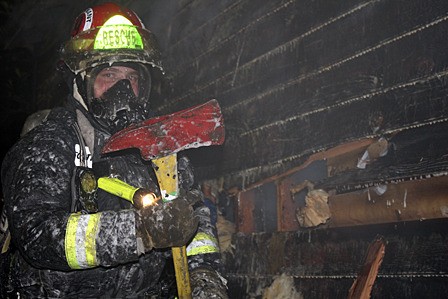by COLLEEN SMITH ARMSTRONG and MEREDITH M. GRIFFITH
What is it like inside a burning building?
It’s hot and disorienting and noxiously smoky.
“Fire doubles every minute,” long-time firefighter Rich Harvey said. “And the smoke is blinding.”
Orcas Fire and Rescue staged a live burning exercise last week in Deer Harbor inside a dilapidated house on Cormorant Bay Road. Property owners Laura and Tony Hasselman gave the department permission to use the condemned building. Orcas Fire is required to do one live burn a year for training purposes.
Around 30 firefighters signed up for the training on Nov. 16, which started at 7 p.m. and lasted until close to midnight. The volunteers were broken into four teams, each with four separate tasks inside the complex structure fire: ventilate the building, attack the fire, provide a second hose line, and search for victims.
Orcas Fire invited Sounder editorial staff to participate in the exercise. We were fitted for fire gear, face masks, and self-contained breathing apparatus (SCBA). On the night of the burn we accompanied firefighters to the site and watched from the sidelines as the pumper trucks, hoses, fans, and tools were set up.
By 8:30 p.m. it was time to enter the building. We knelt two feet from a doorway, flanked by firefighter Harvey and Division Chief Patrick Shepler, as a fire was kindled in a far corner room with a pile of old boards. A spotlight beam blazed in from the fire truck parked outside. Cherry-colored flames started flaring up along the walls, and the room glowed gold. The house went up in flames like a roman candle.
Within three minutes noxious black smoke was boiling toward us, piling down in layers from the ceiling. We watched on hands and knees, just two feet off the floor, struggling to see as the fiery black curtain fell. Everything disappeared: the flames, the door, the massive spotlight beam. Even our two firefighter “buddies” kneeling inches away were invisible to us.
We gulped big lungfuls of air from our tanks, reminding ourselves that we could still breathe. Five minutes in, we tapped along the floor with thick gloved finders, searching for Harvey and Shepler. A quick hand squeeze settled our nerves.
The room was 200 degrees where we were crouched. Above our heads it was closer to 2000 degrees. Fire suits are built to withstand 600 degrees – “after that, it’s just more fuel for the fire,” said fire chief Mike Harris.
Suddenly Shepler and Harvey were yelling, “get out! get out!” They grabbed us, shoved our clumsy bodies to the door, and we spilled from the building, back into the glare of the spotlight.
Seconds after we scrambled out, Harvey was wielding a chainsaw, carving open the cabin’s wooden sides to expose its fiery ribs to an onslaught of foam.
Yanking off our heavy masks, we gratefully breathed in the cold night air.
While our part was done, the work was just beginning for everyone else. The sound of chainsaws and spraying foam would echo in the forest for several more hours.
Orcas Fire had planned to do four interior attacks on the fire, but “we knew we might only get one or two,” Shepler said.
“The structure turned out to be extremely unfriendly and essentially ‘chased’ us out,” he said. “You can see how easily one could get disoriented. That’s why firefighters killed in structure fires each year typically die in single family homes. I could not ‘see’ the way out, but I knew in my mind’s eye before starting what our escape route and plan was. I didn’t think we’d have to initiate it.”
Adding to the problem was a hose that became snagged on the front door; it delayed the attack just enough for the fire to grow to unstoppable proportions.
The fire department auxiliary provided soup, bread, cookies, fruit, and water to help sustain the crew. As soon as one set of firefighters were done, they were sent to “rehab,” where Orcas Fire EMTs checked their vital signs and CO2 levels.
The following day, Orcas Fire burned the building to the ground. Favorable wet weather made the final burn down go quickly.
The exercise proved to be important training for the firefighters.
“It’s very rare that we get an opportunity like this,” Shepler said. “This training is very valuable.”
While this structure was gutted, a real house fire means furniture, art, and clothing going up in flames.
“The fumes are toxic,” Shepler said. “Especially furniture that is treated with chemicals.”
The training also illustrated the importance of working smoke alarms and immediate evacuation. The house went up more quickly than the firefighters anticipated because the old wood was treated with varnish. When we left the burning building, Harvey said it was just five minutes away from “flashover,” when 930’ F gases cause the entire room to spontaneously combust.
“We wouldn’t normally go inside this place unless we had (someone to) rescue,” Shepler said. “One reason we did this at night is because that is when you are more likely to have people at home and you’ll have to go in … we always have three priorities: life safety, instant mitigation (stop the fire), and save the property.”



